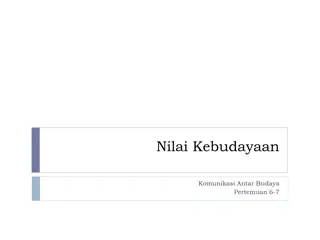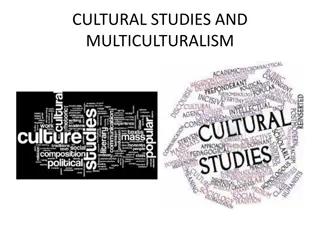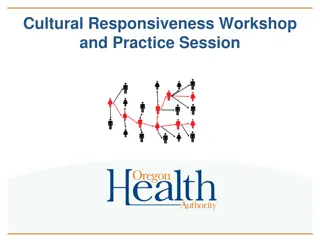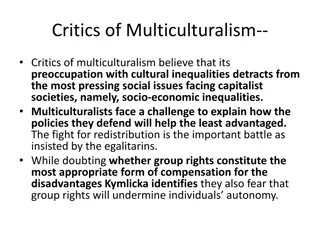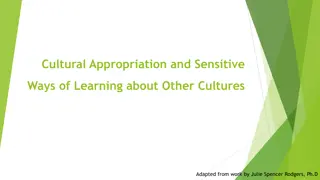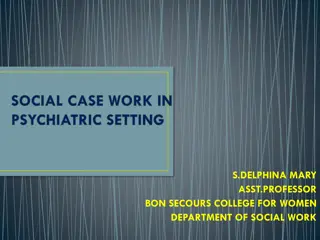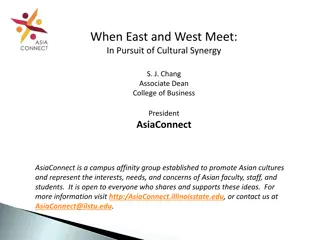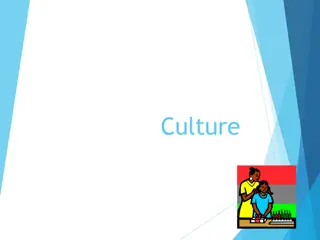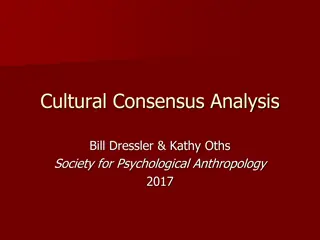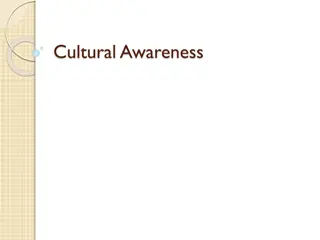Understanding Cultural Adjustment: Navigating Different Ways of Life
Cultural adjustment involves experiencing culture shock when encountering a new way of life due to immigration, travel, or a shift in social environments. This process includes symptoms like excessive concern, fear of physical contact, and refusal to learn the host country's language. Overcoming culture shock involves staying connected with loved ones, seeking positive aspects of the new culture, making friends, learning the language, and adapting to local customs. The adjustment process unfolds through stages like the honeymoon period, culture shock, initial adjustment, mental isolation, and finally, acceptance and integration into the new culture.
Download Presentation

Please find below an Image/Link to download the presentation.
The content on the website is provided AS IS for your information and personal use only. It may not be sold, licensed, or shared on other websites without obtaining consent from the author. Download presentation by click this link. If you encounter any issues during the download, it is possible that the publisher has removed the file from their server.
E N D
Presentation Transcript
Cultural Adjustment By: Neni Kurniawati, M.Hum.
Some of Culture Aspects Belief Customs Gesture Facial expression Words (language) Norms Artifacts etc
Culture Shock A result of total immersion in a new culture Culture shock is the personal disorientation a person may feel when experiencing an unfamiliar way of life due to immigration or a visit to a new country, or to a move between social environments also a simple travel to another type of life Happens to people who suddenly transplanted abroad
Symptoms excessive concern -cleanliness - legality - healthiness, etc Fear of physical contact - get acquainted with new people - hand shake, etc delay and outright refusal to learn the language of the host country
Things to do to overcome the difficulties of culture shock. Keep in touch with friends and family Try to look for logical reasons why things happen. Try not to concentrate on the negative things about your host culture Make an effort to restore communication by making friends in your host culture. Speak the language of the country you are in Take care of yourself by exercising, getting enough sleep, eating properly and doing things you enjoy. Try to fit into the rhythm of life in your host culture. Adjust to their time schedule for meals and work. Find out where people meet and socialize. Make an effort to go to those places and observe.
Adjustment Process In a New Culture 1. Honeymoon Period fascinated and excited by everything new 2. Culture Shock immerse in new problems 3. Initial Adjustment basic ideas and feelings in the second language can be expressed 4. Mental Isolation away from family and cannot express their feelings 5. Acceptance and Integration a routine has been established
Adjustment Process The Re-entry to Previous Culture Adjustment Process: 1. Acceptance and Integration A routine (e.g. work, business, or school) has established. New customs, foods, and characteristics has been accepted by the visitors. been 2. Return Anxiety Since there are changes has been made, the visitors may be nervous of going home. 3. Return Honeymoon When got home, there are parties to welcome back the visitor and renewed friendships to look forward to, taste home town food
Adjustment Process 4. Re-entry Shock Family and friends may not understand or appreciate the travelers has experienced. The native country or city may have changed in the eyes of the former traveler. 5. Re-integration The travelers fully involved with friends, family, activities and feels one again integrated in society.
Individual Reaction The new culture s language comprehension Visitors who have close relatives in the new culture or speak the foreign language fluently, they may not experience all the effects of culture shock or mental isolation. Differ from one culture to another or voluntary and refugee Self-understanding individuals experience the stages of adjustment and re- entry in different ways.
References www.sdsu.edu.com





